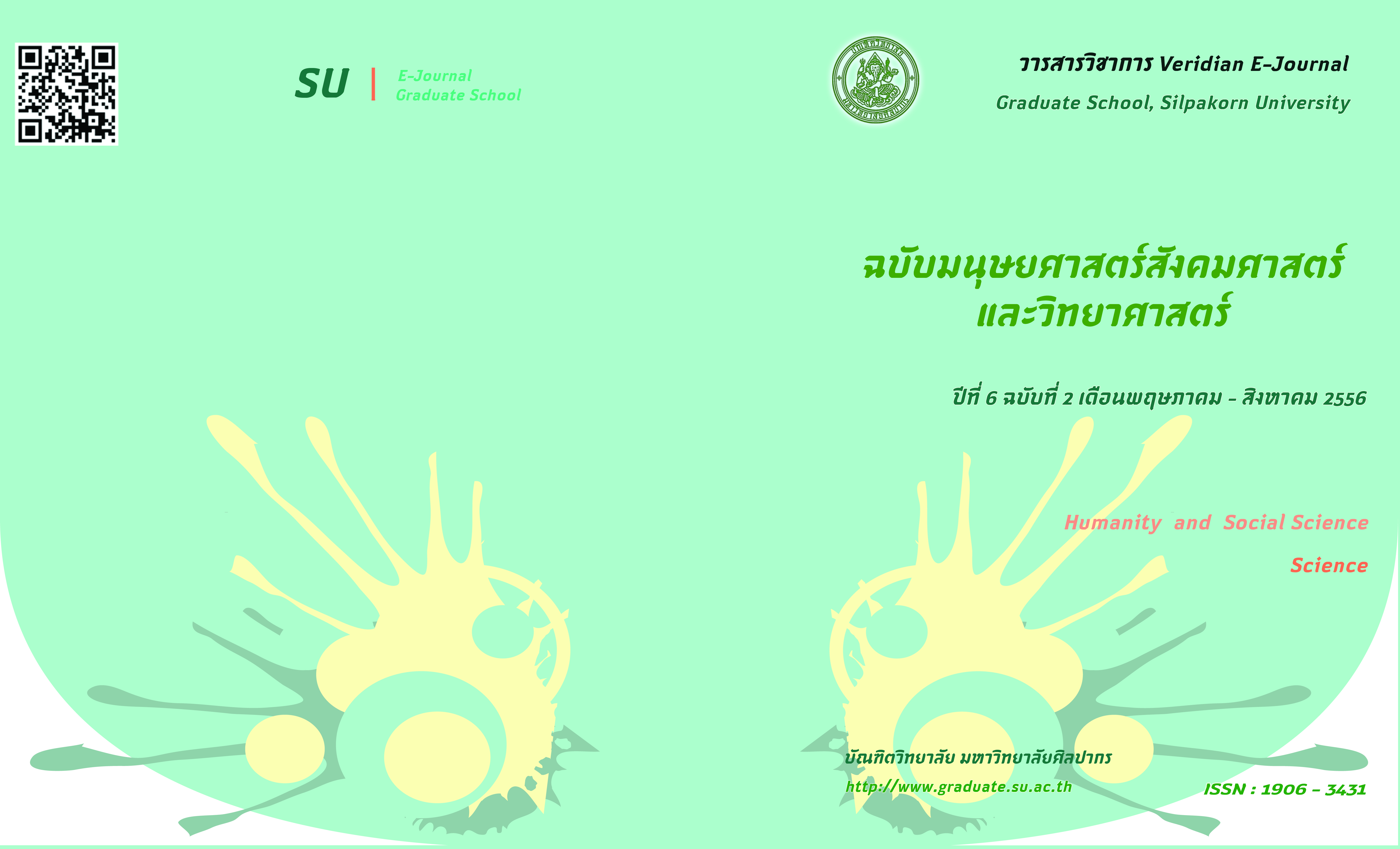ปฏิสัมพันธ์ระหว่างการเรียนร่วมกันแบบผสมผสานที่ใช้เทคนิคการคิดแนวข้างต่างกัน กับนักศึกษาที่มีระดับความคิดสร้างสรรค์ต่างกัน ที่ส่งผลต่อความคิดสร้างสรรค์ของนักศึกษา คณะนิเทศศาสตร์ สาขาวิชาการโฆษณา
Main Article Content
Abstract
บทคัดย่อ
การวิจัยในครั้งนี้มีวัตถุประสงค์เพื่อ 1) เปรียบเทียบคะแนนความคิดสร้างสรรค์หลังเรียนของผู้เรียนที่มีระดับความคิดสร้างสรรค์ต่างกัน ที่เรียนด้วยการเรียนร่วมกันแบบผสมผสานโดยใช้เทคนิคการฝึกคิดแนวข้าง 2) เปรียบเทียบคะแนนความคิดสร้างสรรค์หลังเรียนของผู้เรียนที่เรียนด้วยเทคนิคการฝึกคิดแนวข้างต่างกัน 3) ศึกษาปฏิสัมพันธ์ระหว่างการเรียนร่วมกันแบบผสมผสานโดยใช้เทคนิคการฝึกคิดแนวข้างต่างกันกับระดับความคิดสร้างสรรค์ของผู้เรียนที่มีระดับความคิดสร้างสรรค์ต่างกัน
กลุ่มตัวอย่างเป็นนักศึกษาระดับปริญญาตรี คณะนิเทศศาสตร์ มหาวิทยาลัยเกษมบัณฑิต ปีการศึกษา 2555 จำนวน 60 คนได้มาโดยวิธีการสุ่มอย่างง่าย แบ่งกลุ่มตัวอย่างออกเป็น 2 กลุ่มๆ ละ 30 คน (Matching Method) โดยใช้ผลคะแนนความคิดสร้างสรรค์จากการทดสอบก่อนเรียน จากนั้นแบ่งกลุ่มตัวอย่างออกเป็น 2 กลุ่มย่อย กลุ่มละ 15 คน ตามระดับความคิดสร้างสรรค์สูงและต่ำเพื่อเข้ารับการทดลอง 10 สัปดาห์
เครื่องมือในการวิจัยประกอบด้วย 1) การจัดการเรียนการสอนร่วมกันแบบผสมผสาน ที่ใช้เทคนิคการฝึกคิดแนวข้าง ได้แก่ แบบเลี่ยงความคิดครอบงำและแบบสร้างแนวคิด โดยจัดการเรียนในชั้นเรียนร้อยละ 70 และการเรียนอีเลิร์นนิงร้อยละ 30 2) บทเรียนอีเลิร์นนิง รายวิชานิเทศศิลป์กับงานโฆษณาที่ใช้เทคนิคการฝึกคิดแนวข้าง ได้แก่ แบบเลี่ยงความคิดครอบงำและแบบสร้างแนวคิด 3) เครื่องมือประเมินคะแนนความคิดสร้างสรรค์ ประกอบด้วย แบบทดสอบความคิดสร้างสรรค์ที่ใช้รูปภาพเป็นสื่อแบบ ก ของ Torrance และแบบประเมินความคิดสร้างสรรค์จากชิ้นงานที่ผู้วิจัยสร้างขึ้น
สถิติที่ใช้ในการวิจัยในครั้งนี้ ได้แก่ ค่าร้อยละ ค่าเฉลี่ย ส่วนเบี่ยงเบนมาตรฐาน การทดสอบค่าที
(t-test independent) และ two-way Anova ผลการวิจัยพบว่า 1) คะแนนความคิดสร้างสรรค์ ตามการประเมินด้วยแบบทดสอบความคิดสร้างสรรค์ของ Torrance พบว่า ผู้เรียนที่มีระดับความคิดสร้างสรรค์ต่ำและสูง มีคะแนนความคิดสร้างสรรค์หลังเรียนแตกต่างกันอย่างมีนัยสำคัญที่ .05 ผลการประเมินด้วยแบบประเมินความคิดสร้างสรรค์จากชิ้นงาน พบว่า ผู้เรียนที่มีระดับความคิดสร้างสรรค์ต่ำและสูง มีคะแนนความคิดสร้างสรรค์หลังเรียนไม่แตกต่างกันอย่างมีนัยสำคัญที่ .05 2) การเปรียบเทียบคะแนนความคิดสร้างสรรค์หลังเรียนด้วยเทคนิคการฝึกคิดแนวข้างต่างกัน พบว่า คะแนนความคิดสร้างสรรค์ของผู้เรียนหลังเรียน ไม่แตกต่างกันอย่างมีนัยสำคัญที่ .05 3) การศึกษาปฏิสัมพันธ์ พบว่า ไม่มีปฏิสัมพันธ์ระหว่างการจัดการเรียนการสอนที่แตกต่างกันกับระดับความคิดสร้างสรรค์ที่แตกต่างกันของผู้เรียน ที่ส่งผลต่อคะแนนความคิดสร้างสรรค์ของผู้เรียนอย่างมีนัยสำคัญที่ .05
Abstract
The objectives of this study were to 1) compare the creativity score of students who had different levels of creativity, after taking the collaborative blended learning using lateral thinking techniques, 2) compare the creativity score of students after taking collaborative blended learning using different lateral thinking techniques, and 3) study the interactions between collaborative blended learning using different lateral thinking techniques with different levels of students’ creativity influencing the creativity of students.
The subjects were 60 undergraduate Communication Arts students of Kasem Bundit University majoring in Advertising, Academic year 2012 selected based on a Simple Random Sampling Method. The samples were divided into 2 groups: 30 students per group (Matching Method), by using their creativity scores from a pretest. Then each group was divided into 2 small groups: high and low level of creativity containing 15 students per group to obtain the treatments for 10 weeks. The research instruments were as follows: 1) A Collaborative blended learning using 2 different lateral thinking techniques; Avoiding Domain Idea and Generating Idea techniques. The proportion of blended learning consisted of 70 percent in classroom and 30 percent online. 2) e-Learning lessons using 2 different lateral thinking techniques: Avoiding Domain Idea and Generating Idea techniques. 3) The research instruments for measuring students’ creativity scores were the Torrance Tests of Creative Thinking (TTCT) and the Creative Thinking Evaluation Forms (CTEF) measuring creativity scores of students from their projects.
The Statistics used in this study were mean, percentage, standard deviation, independent t-test, and f-test for two ways Anova.
The findings of the study revealed that: 1) after the treatments, the students' creativity scores obtaining high and low levels of creativity from the TTCT were significantly different at the .05 level, and the students' creativity scores obtaining high and low levels of creativity from the CTEF were not significantly different at the .05 level 2) after taking different collaborative blended learning using different lateral thinking techniques, the creativity scores of the students were not significantly different at the .05 level 3) there was no interaction between collaborative blended learning using different lateral thinking techniques with different levels of students’ creativity influencing the creativity of students.
